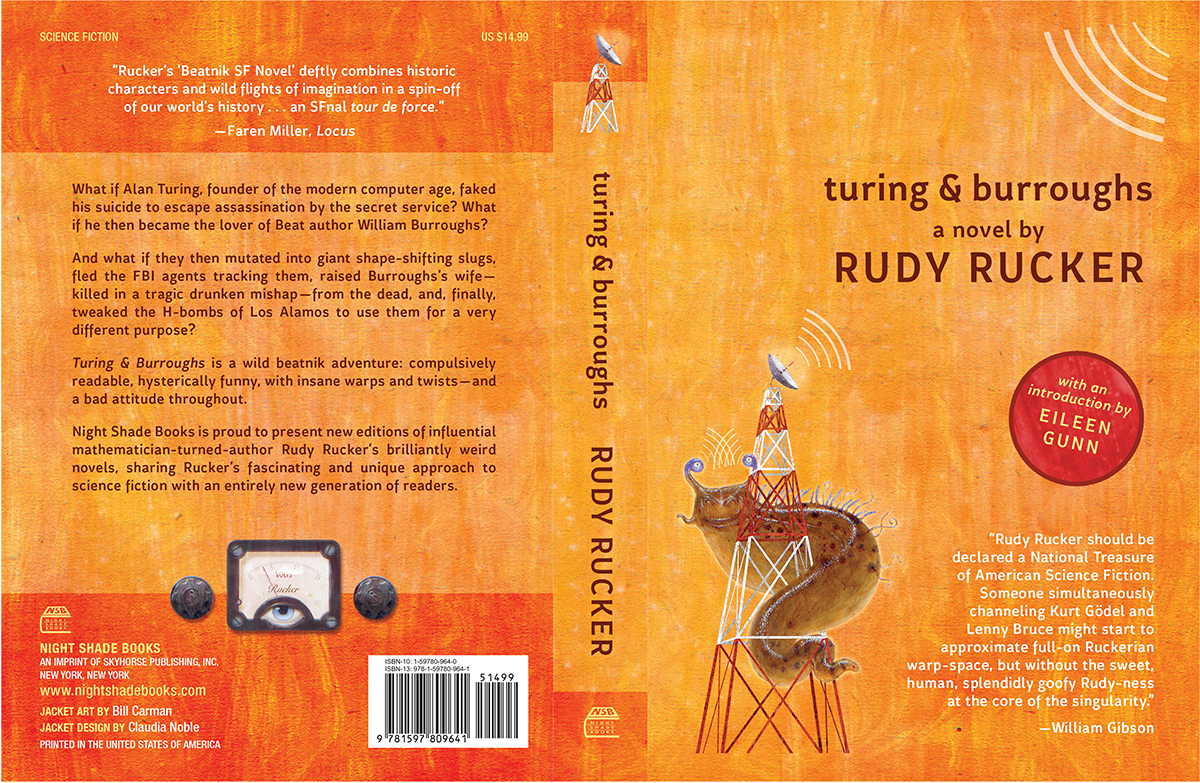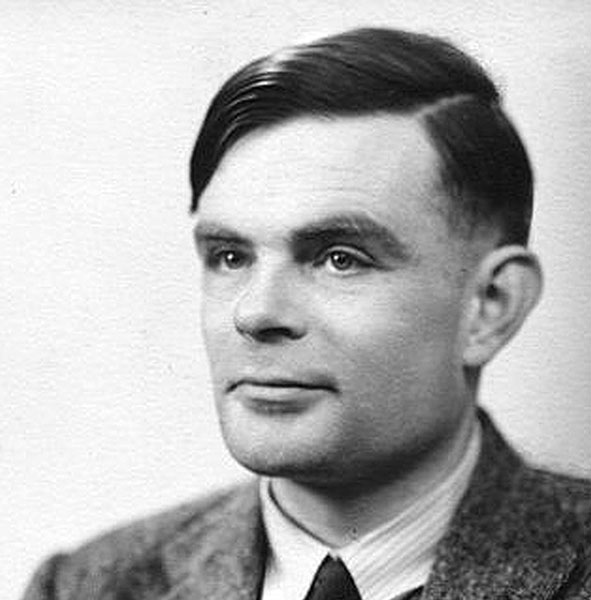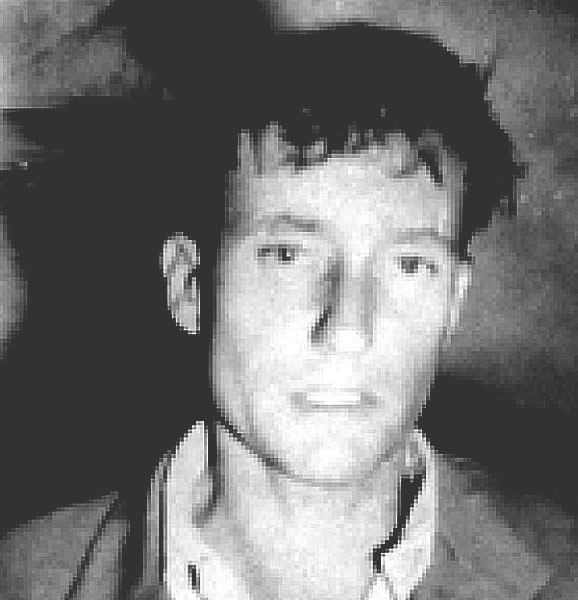Turing & Burroughs, by Rudy Rucker 
Turing & Burroughs Paperback: Night Shade Books, January, 2019, 2nd Edition, with introduction by Eileen Gunn. Paperback: Amazon or Barnes & Noble. See Rucker's other nine Night Shade books. SummaryWhat if Alan Turing, founder of the modern computer age, escaped assassination by the secret service to become the lover of Beat author William Burroughs? What if they mutated into giant shapeshifting slugs, fled the FBI, raised Burroughs’s wife from the dead, and tweaked the H-bombs of Los Alamos? A wild beatnik adventure, compulsively readable, hysterically funny, with insane warps and twists—and a bad attitude throughout. Writing NotesNotes for Turing & Burroughs. My 171 page Acrobat PDF file, to download or read online. Includes many illos and links. ReviewsRucker's novels have ... an angle of attack reminiscent of the Thomas Pynchon of Gravity's Rainbow and the Terry Southern of The Magic Christian. Turing & Burroughs is all of that and more. Much more. It is Rudy Rucker's most ambitious novel, and while perhaps not a perfect success, it is a success. ... Turing & Burroughs is centrally the story of an imaginary gay affair between William Burroughs and Alan Turing. ... Rucker being Rucker, this central story line is not even half the bizarre, fascinating, scientific, sexual, and historical content of this delightfully humorous yet somehow thematically serious novel. ... That this novel was not bought by a major publisher or at least published in a main SF line is a grim comment on the current state of the soul of the American publishing industry. The book opens in 1954, with a gracefully channeled version of Alan Turing—that historically real cybernetic icon of misunderstood genius. The scene is set with vibrant verisimilitude… But Turing’s life soon goes counterfactual, and he’s on the lam to Tangier where he hooks up with William Burroughs, notorious louche Beatnik junkie and scribbler of transgressive fiction. … Pretty soon, out of dire necessity, he’s invented a totipotent shape-changing form of life—a “skug”—that establishes a strange symbiosis with him and Burroughs. … Rucker accomplishes a significant feat by mashing up Greg Bear-level speculations with a kind of On the Road vibe, full of slang-laden hipster contempt for the Establishment and a desire to break free of stifling conventions. Turing’s adoption of Beat philosophy consorts perfectly with his known biographical proclivities, and seems extremely plausible and even predestined, once given the initial violent tweak to his career. The Eisenhower-era conformity and general societal suspicion of weirdos is a perfect adventure matrix for these ultimate outsiders: chimeric, telepathic slugs. Rucker’s “Beatnik SF Novel” deftly combines historic characters and wild flights of imagination in a spin-off of our world’s history, 1954-1955. … Turing & Burroughs can be enjoyed as a mad romp … that brings together and transforms two characters from history in outrageous ways. In less than 250 pages—room enough for a host of voices—Rudy Rucker has produced an SFnal tour de force. … The prose in Turing & Burroughs can flow like a drug-stoked dream. The enigmatic death of Alan Turing has long haunted those who inquire into the life of this pioneer of computer science. [Turing] knew all the deepest secrets of Britain's wartime work in cryptanalysis, and having been shamefully persecuted by the government for his homosexuality, might have been considered a security risk and targeted to be silenced by dark forces of the state. This is the point of departure for this delightful alternative history romp set in the middle of the 1950s. In the novel, Turing is presumed to have gotten much further with his work on biological morphogenesis than history records. So far, in fact, that when agents from Her Majesty's spook shop botch an assassination attempt and kill his lover instead, he is able to swap faces with him and flee the country to the anything-goes international zone of Tangier. … In this novel, Rucker immerses the reader in the beat milieu, with the added twist that here they really are pod people, and loving it. No doubt the beats considered themselves superior to the straights. But what if they actually were? How would the straights react, and how would a shape-shifting, telepathic, field-upgradable counterculture respond? … Among the many treats awaiting the reader is the author's meticulous use of British idioms when describing Turing's thoughts and Burroughs's idiosyncratic grammar in the letters in his hand which appear here. This novel engages the reader to such an extent that it's easy to overlook the extensive research that went into making it authentic, not just superficially, but in depth. From the AuthorWhy did I write a beatnik SF novel about William Burroughs and Alan Turing? In short, I’d come to think of them as my friends, and I wanted to show them a good time. Would Turing mind? Late in his life, at the suggestion of a therapist, Turing actually made a start at writing a semi-autobiographical science-fiction tale. To some extent this allays any uneasiness I might feel about dragging the man’s name into the mud of transreal SF! As for Burroughs—hell, looked at in the right way, the man was an SF writer like me. He definitely would have liked skugs.
Turing was a heroic and inspiring figure, well ahead of his time. He worked on deeply fascinating things without getting lost in in the merely technical. For instance, he proved it’s impossible to create a general program that will predict how long all the other programs will run. That is, there’s no master computation that knows in advance what all the other computations will do. To my way of thinking, this connects, in a roundabout way, with the fact that, if you’re an author working at the limits of your power, it’s impossible to predict where your novel is going to go. Your mind is a computation, but you can’t predict what it’ll do. Near the end of his life, Turing was looking into how certain biocomputational mixtures of chemicals will produce patterns, such as the ones you see in the coats of animals. In this vein, he wrote a paper, “The Chemical Basis of Morphogenesis,” where he did an immense calculation—and his output was a single black blob, like you’d see on the back of a brindle cow. This makes me love Turing—the image of the great mathematician doing a huge computation by hand. Another other compelling aspect of the Turing story is that he was openly gay, he was persecuted for it, and he had a strange, tragic death—which is usually described as a suicide. Turing was a fan of the movie Snow White, with the poison apple. He was said to have danced down a university corridor singing songs from the movie. And he was found dead with an apple that had cyanide on it. The authorities announced that Turing put the cyanide on the apple himself. A weird way to kill himself. I’ve always felt there’s a possibility that Turing was in fact assassinated by agents of the British government. This seems somewhat plausible, given that Turing was involved in that top-secret code-breaking effort during World War II. Keep in mind that he died in the 1950s, when there was a collective hysteria over homosexuals being security risks. Turing was anything but secretive or downcast about his predilections. He was stubborn, unrepentant, impulsive, and warm. And, like many mathematicians and computer scientists, he was socially unaware. He’d say whatever he thought—he might even say to a man, “I’m a homosexual. Would you like to have sex with me tonight?” In the 1950s in England this was not done. Alan is a great character to write about. Somehow I had the idea of having Turing escape assassination and meet up with William Burroughs in Tangier. Two brilliant men, gay, outcast—they hit it off. In my story, Turing intensifies his biotech to the point where he can turn his body into a huge slug, or skug, that slimes around. And his condition is contagious. It’s vintage 1950s-style mutant invasion SF.
I’m a huge Burroughs fan. I’ve always liked his attitude—so completely in your face, with no compromise. “Homosexuality is what I like.” And he was funny about it. And the same with the drugs. I’ve studied Burroughs’s papers very closely over the years, and I wrote some of the chapters in the form of being letters or journals from him. One of my challenges in writing a William Burroughs character was that I had to deal with the fact that, a couple of years before the start of my novel, Burroughs had shot and killed his wife Joan in Mexico City. At first I felt like this was too explosive and difficult to write about directly. But then I realized that I had to face the killing. So my Turing and Burroughs end up going to Mexico City, resurrecting Joan, and letting her run some routines on Burroughs. I wanted to give Joan a voice, and to give her a chance to get even. The experience of writing this chapter was heavy and ecstatic. I’m always happy when I’m emulating Bill Burroughs. You might say the theme of Turing & Burroughs is this. You can turn off the machines and get wiggly. Especially if you’re Burroughs, and even if you’re Alan Turing. Long may they wave. MoreFree online browsing edition of the ebook. Link to the passage in the free browsing edition where Joan gets even with Burroughs by coming back to life and shooting him in the forehead. (Long overdue payback!) Interviews with Rucker about the novel: Turing Centenary blog, and Duckter Yezno's webzine. Podcasts including Rucker's talks and readings. I wrote the first chapter of my Turing novel in 2006, read it in public a couple of times, and published it in Interzone in 2008. My story was called "The Imitation Game." But Turing and Burroughs has no connection with the 2014 Turing movie The Imitation Game, nor with the 1980 play of that same name. |

